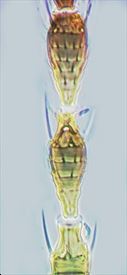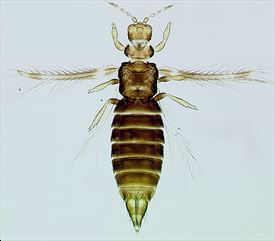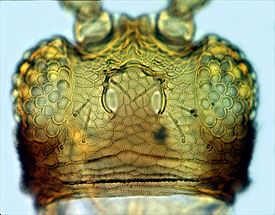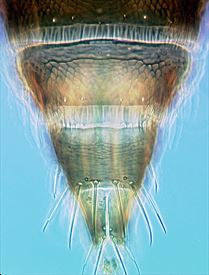Distinguishing features
Both sexes fully winged. Body brown, head with pair of yellow longitudinal areas; legs yellow, mid and hind femora brown; antennal segments III–V largely yellow; fore wing brown but pale at apex and sub-basally, and with submedian area variably lighter. Head reticulate with transverse occipital ridge; ocellar setae III on anterior margins of triangle; three pairs of postocular setae present. Antennae 8-segmented, III and IV each with sense cone forked. Pronotum with no long setae. Metanotum reticulate medially, median setae arise medially. Tarsi all 2-segmented. Fore wing with two complete rows of setae, posteromarginal cilia wavy. Abdominal tergites weakly reticulate medially, median pair of setae small; posterior margins without a craspedum, VIII with comb of microtrichia laterally; tergite X with longitudinal split almost complete.
Male with sternal marginal setae minute, sternites III–VII with slender transverse pore plate.
Related species
Nine species are recognized in the genus Hercinothrips, all of them originally from Africa. Two are now widespread around the world, but a third, H. dimidiatus, was found in Portugal in 2015 causing damage to cultivated Aloe arborescens. H. femoralis is very similar to H. bicintus, but has the fore wings extensively dark medially. Hercinothrips species are unusual amongst Panchaetothripinae in having 2-segmented tarsi, and the fore wing with both longitudinal veins bearing a complete row of setae.
Biological data
Adults and larvae usually live on mature leaves, but of many different plant species with no obvious pattern of association.
Distribution data
Originally from Africa, but now widespread around the world in tropical and subtropical areas (Roditakis et al., 2006). Also common in temperate areas in greenhouses. Recently recorded from the Carpathian mountain area in Slovakia (more than 1,000 m a.s.l., coldest altitudes ever published) (Masarovic et al., 2014). In New Zealand collected at Christchurch in 1934, in the potting shed at the Botanical Gardens.
Family name
THRIPIDAE, PANCHAETOTHRIPINAE
Species name
Hercinothrips femoralis (Reuter)
Original name and synonyms
Heliothrips femoralis Reuter, 1891: 166
Heliothrips cestri Pergande, 1895: 390
Heliothrips apicalis Bondar, 1931: 86
References
Masarovic R, Doricová M, Prokop P, Fedor P (2014) “Testing the limits” — an interesting record of the exotic banded greenhouse thrips Hercinothrips femoralis (Thysanoptera: Thripidae: Panchaetothripinae) at high Carpathian mountain altitudes. Biologia (Bratisl). 69: 1631–1634.
Roditakis E, Mound LA, Roditakis NE (2006) First record in Crete of Hercinothrips femoralis in greenhouse banana plantations. Phytoparasitica, 34: 488–490.
zur Strassen R (2003) Die terebranten Thysanopteren Europas und des Mittelmeer-Gebietes. Die Tierwelt Deutschlands 74: 1–271.





